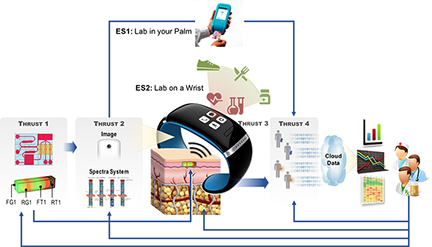A Texas A&M University-led consortium has received support from a local, innovative telemonitoring device and service company to support diabetes and heart disease research.
The Texas A&M Precise Advanced Technologies and Health Systems for Underserved Populations (PATHS-UP) has been working since September 2017 to study remote wearable technology to help people monitor and manage diabetes and heart disease in underserved communities. The PATHS-UP project received funds from a National Science Foundation (NSF) Engineering Research Center (ERC) grant.
 Recently, members of the consortium, including Dr. Mark Lawley, head of the Department of Industrial and Systems Engineering and deputy director of the Center for Remote Health Technologies and Systems, visited with Coordination Centric, a telemonitoring device and service company with offices in Bryan and McAllen. The parties involved sought to collaborate to better enable advanced technologies to improve the health of those in underserved communities.
Recently, members of the consortium, including Dr. Mark Lawley, head of the Department of Industrial and Systems Engineering and deputy director of the Center for Remote Health Technologies and Systems, visited with Coordination Centric, a telemonitoring device and service company with offices in Bryan and McAllen. The parties involved sought to collaborate to better enable advanced technologies to improve the health of those in underserved communities.
The telemonitoring services provided by Coordination Centric assist health care providers in preventing, delaying the onset and managing diabetes and cardiovascular disease by using advanced technologies and medical devices.
"Texas A&M and Coordination Centric have similar goals," said Ives Soto, director of provider relations at Coordination Centric. "We believe that we can help improve healthcare in our communities through the use of advanced technologies and ultimately reduce healthcare costs."
Lawley said there are four phases to the research, starting with developing biometric sensors to measure readings such as blood glucose and those seen as symptoms of cardiovascular disease and then developing an optical reader that can activate the sensor.
“We’ll be designing a sensor that’s going to be about the size of grain of rice that will be inserted underneath the patient’s skin,” Lawley said. “It has no power in it, no battery or anything like that.”
Researchers aim to make the wearable readers light and sleek so they can better integrate into a person’s lifestyle. The last research thrust is to develop a way to look at the data from the sensor through different techniques such as artificial intelligence, machine learning and statistical learning.
“One thing we’re quite interested in is studying the way physicians use the information coming from this technology, how it affects their workflow and helping them integrate that better into their daily activities so that they improve not only the quality of their patients’ lives but also the quality of their own lives,” Lawley said.
This is where telemonitoring with Coordination Centric can play a role, as it involves a physician remotely monitoring patients who suffer from these diseases. Patients can be taught to take daily vital signs that are then automatically and securely sent to their physician, which helps the physician take proactive measures when necessary.
"We believe this relationship will be meaningful in developing transformational healthcare technologies and most definitely propel our efforts in solving high risk healthcare problems,” Lawley said. “The outcome is the relationship and a remote health study using patients and clinicians from the RGV as a test group to determine remote patient monitoring efficacy.”
The NSF ERC is an interdisciplinary initiative with Florida International University, Rice University and the University of California at Los Angeles, as well as several companies and other federal agencies.